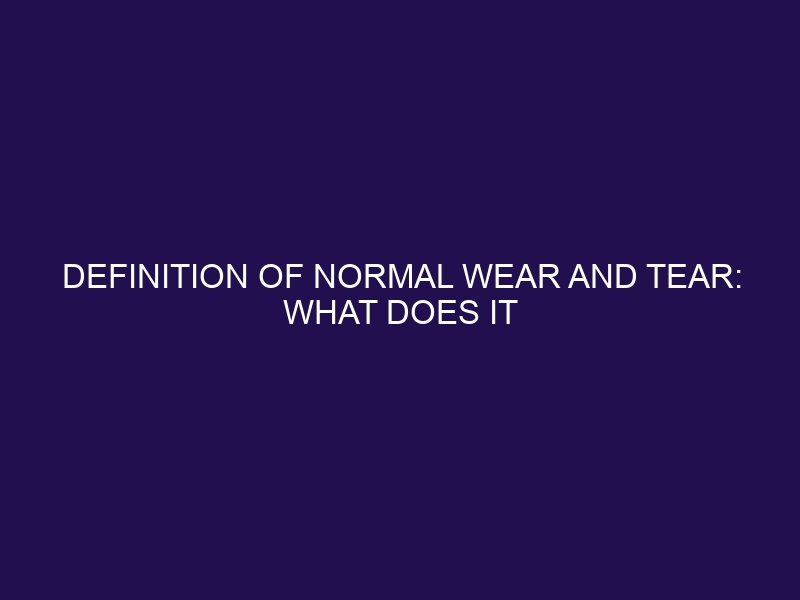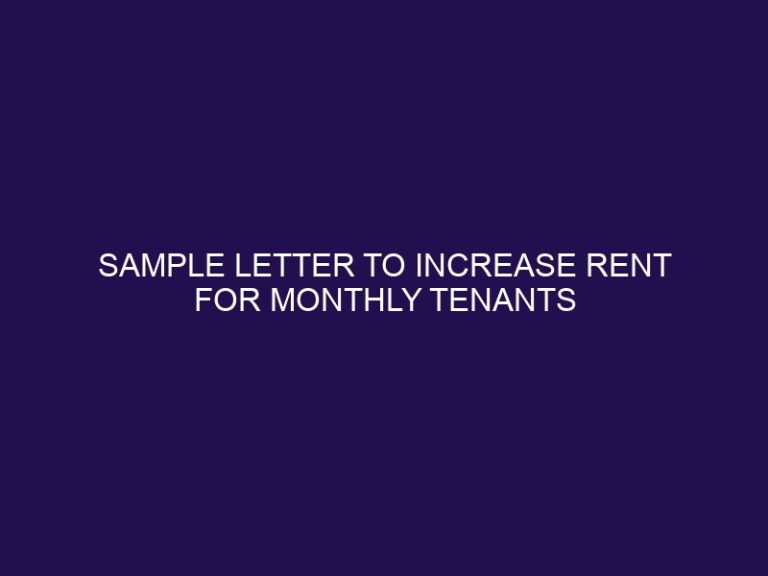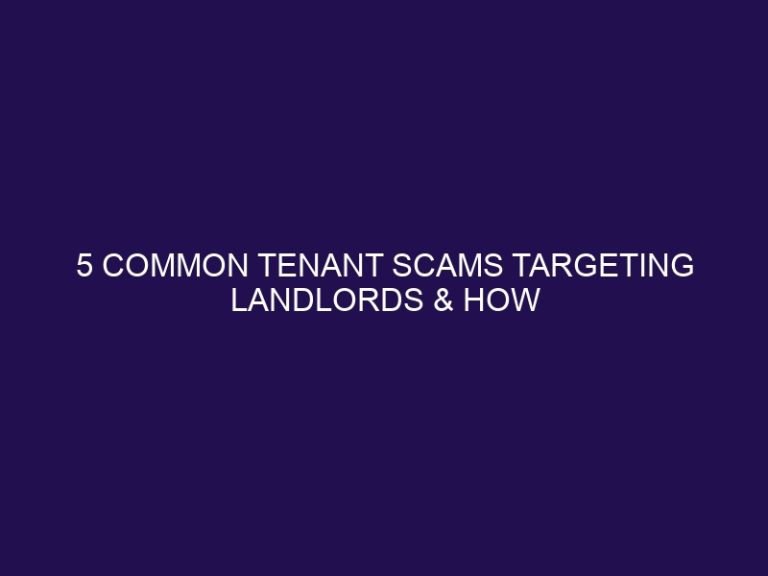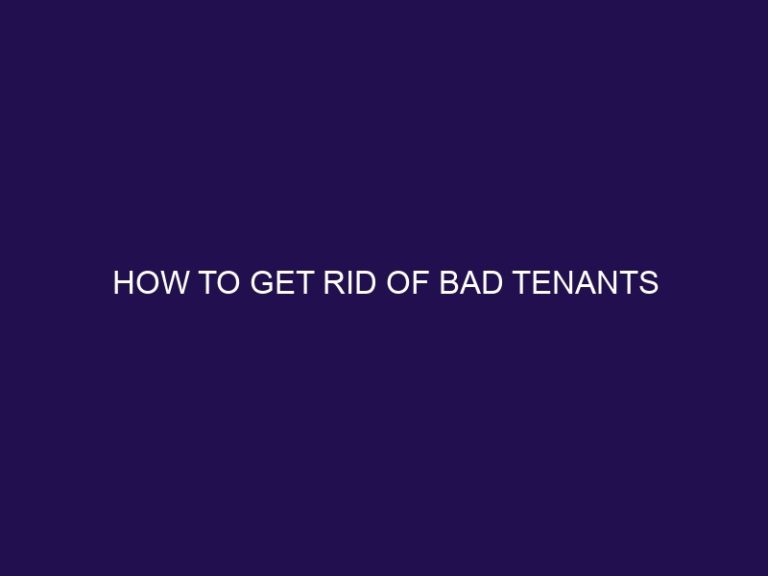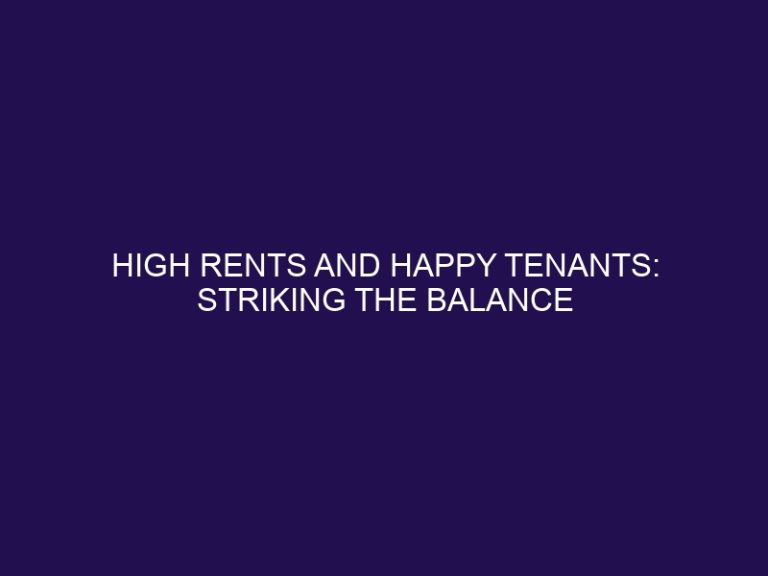Definition of Normal Wear and Tear: What Does It Actually Mean?
Normal wear and tear is a term used to describe the gradual deterioration of an object or property due to regular and reasonable use. It is a natural and unavoidable process that occurs over time and does not result from any negligence or intentional damage. The concept of normal wear and tear is often a source of dispute between landlords and tenants, making it crucial to understand its definition and implications.
According to the legal definition, normal wear and tear is the “unavoidable deterioration of a property resulting from normal use and exposure.” This means that any damage or deterioration that occurs due to regular use, age, or weather conditions is considered normal wear and tear. It is important to note that normal wear and tear may vary depending on the type and quality of the property.
There are three types of normal wear and tear:
- Physical wear and tear: This refers to the visible deterioration of a property’s physical components, such as worn-out carpet, scuffed floors, or chipped paint.
- Functional wear and tear: This type of wear and tear affects the functionality of a property, such as a malfunctioning appliance due to regular use.
- Wear and tear due to age: As a property ages, wear and tear become more evident, leading to a decline in its value and function.
The key difference between normal wear and tear and damage is that normal wear and tear occurs naturally and gradually, while damage is a result of negligence, misuse, or intentional actions. For example, a scratched countertop due to regular use would be considered normal wear and tear, whereas a burn mark caused by a hot pan would be considered damage.
Determining normal wear and tear in a rental property can be subjective, which is why landlords and tenants should establish clear guidelines. Here are some methods to determine normal wear and tear:
- Checklists and documentation: Landlords can provide detailed checklists and documentation of the property’s condition before and after the tenancy to compare any changes.
- Before and after photos: Taking photos of the property before and after the tenancy can provide visual evidence of any changes.
- Third-party inspection: A professional inspection by a third-party can provide an unbiased assessment of the property’s condition.
Both landlords and tenants have responsibilities when it comes to normal wear and tear. Landlords are responsible for normal wear and tear, while tenants are responsible for any damages caused by their actions or negligence. In case of a dispute, here are some ways to handle it:
- Communication and documentation: It is essential to keep open communication and document any discussions or agreements to resolve disputes.
- Mediation: A neutral third-party can assist in resolving disputes through mediation and finding a mutually agreeable solution.
- Legal action: If all other options fail, legal action can be taken through small claims court. It is important to have proper documentation and evidence to support your case.
Key Takeaways:
What Is Normal Wear And Tear?
Normal wear and tear refers to the expected deterioration of a property due to ordinary use. This can include minor scuffs, light scratches, and natural aging. It is important for both tenants and landlords to understand what is considered normal wear and tear during property inspections and when creating lease agreements.
How Is Normal Wear And Tear Defined?
- The definition of normal wear and tear is the gradual deterioration of a property due to everyday use.
- This includes natural aging, expected depreciation, and unavoidable breakdowns.
- The definition is influenced by factors such as the duration of the lease and the tenant’s lifestyle.
Did you know? Landlords cannot charge tenants for normal wear and tear.
What Are The Types Of Normal Wear And Tear?
As a landlord, it is important to understand the concept of normal wear and tear in order to properly assess any damages made to your rental property. In this section, we will explore the different types of normal wear and tear and what each one entails. From physical wear and tear to functional wear and tear and even wear and tear due to age, we will discuss the various ways in which a property can naturally deteriorate over time.
1. Physical Wear And Tear
- Inspect property for scuff marks, worn flooring, and minor paint scratches.
- Document with photos and written notes.
- Assess if any damage is considered normal physical wear and tear.
True story: Upon move-out, the tenant’s security deposit was retained due to substantial wall damages beyond what could be considered normal physical wear and tear.
2. Functional Wear And Tear
Functional wear and tear refers to the natural deterioration of systems or components that impacts their functionality, such as plumbing or electrical systems in a rental property.
In 1964, the Ford Mustang made a significant impact on automotive history, revolutionizing the idea of a sporty car for the general public.
3. Wear And Tear Due To Age
- Assess the age-related deterioration of structural components such as flooring, walls, and appliances.
- Evaluate the impact of aging on the property’s functional aspects, such as HVAC systems and plumbing.
- Consider the natural wear and tear due to age on fixtures and fittings caused by prolonged use.
What Is The Difference Between Normal Wear And Tear And Damage?
Normal wear and tear is a result of ordinary use, while damage occurs from misuse or neglect. For instance, carpet that is worn from regular foot traffic is considered wear and tear, whereas pet stains or burns are classified as damage. It is important for tenant-landlord agreements to clearly distinguish between these two types of issues.
How To Determine Normal Wear And Tear In A Rental Property?
As a landlord or tenant, understanding the concept of normal wear and tear is crucial in maintaining a fair and harmonious rental agreement. But how exactly do we determine what is considered normal wear and tear in a rental property? In this section, we will cover three methods that can help accurately assess the state of the property: using checklists and documentation, taking before and after photos, and enlisting the help of a third-party inspector. By utilizing these techniques, we can avoid disputes and ensure a smooth move-in and move-out process.
1. Checklists And Documentation
- Utilize comprehensive checklists to itemize the condition of the property before and after tenancy.
- Record any pre-existing damage or wear with detailed descriptions and photographs.
- Be sure to include dates and signatures to validate the authenticity of the documentation.
2. Before And After Photos
Before and after photos are essential pieces of evidence when assessing normal wear and tear in a rental property. These visual records allow landlords and tenants to compare the condition of the property at the beginning and end of the lease, facilitating fair assessments and potential dispute resolutions.
3. Third-Party Inspection
- Research: Find reputable third-party inspection companies.
- Book: Schedule the third-party inspection with the chosen company.
- Inspection: Accompany the inspector during the property assessment.
- Report: Obtain a detailed report outlining the property’s condition.
- Review: Use the report to address any wear and tear issues.
What Are The Landlord’s Responsibilities For Normal Wear And Tear?
Landlords have a responsibility to cover the costs of normal wear and tear, which excludes damages caused by tenants. This includes maintaining the habitability of the property, ensuring essential systems are functional, and addressing natural aging of the property. However, landlords are not liable for damages resulting from tenant negligence or misuse.
What Are The Tenant’s Responsibilities For Normal Wear And Tear?
Tenants are responsible for maintaining the property in good condition, ensuring regular cleaning, and promptly reporting any damages. They should also adhere to the lease agreement’s guidelines for maintenance and upkeep, and refrain from causing excessive wear and tear on the property, as outlined in the question “What Are The Tenant’s Responsibilities For Normal Wear And Tear?”
How To Handle Disputes Over Normal Wear And Tear?
When it comes to renting a property, disputes over normal wear and tear can often arise between landlords and tenants. In this section, we will discuss effective ways to handle these disputes in a peaceful and fair manner. From open communication and proper documentation to seeking mediation or taking legal action, we will explore the different steps that can be taken to resolve conflicts over normal wear and tear. By understanding these options, both landlords and tenants can avoid unnecessary stress and reach a mutually beneficial solution.
1. Communication And Documentation
Effective handling of disputes over normal wear and tear involves:
- Communication and Documentation: Maintain clear, open communication and thorough documentation throughout the tenancy.
- Mediation: Seek professional mediation to resolve disagreements impartially and amicably.
- Legal Action: As a last resort, consider legal action if mediation fails to provide a resolution.
In a similar tone, the 1787 Constitutional Convention in the United States resolved disputes through extensive communication and meticulous documentation, paving the way for the drafting of the U.S. Constitution.
2. Mediation
- Initiate Communication: Open a dialogue between the landlord and tenant to express concerns and seek common ground.
- Neutral Third Party: Engage a mediator to facilitate discussions and assist in finding mutually agreeable solutions.
- Agreement: Document any agreements reached during mediation to avoid future disputes.
3. Legal Action
- Communication: Initiate clear and polite communication with the other party.
- Documentation: Gather all relevant documents, such as the lease agreement, photos, and inspection reports.
- Mediation: Consider professional mediation services to reach a fair resolution.
- Legal Action: As a last resort, seek legal guidance and take necessary legal action for resolution.
Frequently Asked Questions
What is the definition of normal wear and tear in a rental lease?
The definition of normal wear and tear in a rental lease is the expected decline and deterioration of a property due to normal everyday use, not caused by neglect or abuse.
What are some examples of normal wear and tear?
Some examples of normal wear and tear include minor scrapes or dings on floors, fading carpet, and worn appliances.
What is the difference between normal wear and tear and tenant damages?
Normal wear and tear is caused by natural deteriorations over time, while tenant damages are caused by neglect or abuse. Examples of tenant damages include large scrapes or holes in floors, significant stains or holes in carpet, and broken appliances.
What are the three basic types of damages that can occur in a rental unit?
The three basic types of damages that can occur in a rental unit are normal wear and tear, tenant damages, and extra damage.
What are the tenant’s responsibilities when it comes to maintenance and repairs?
The tenant’s responsibilities may include taking out the garbage, replacing lightbulbs, and keeping the property clean. They are also responsible for informing the property manager of any issues or damages that may occur during their tenancy.
What are the landlord’s responsibilities when it comes to maintenance and repairs?
The landlord’s responsibilities include maintaining the property and addressing any issues or damages caused by natural wear and tear. They are also responsible for conducting a thorough check-in inspection with the tenant to document the condition of the property before the tenant moves in.

